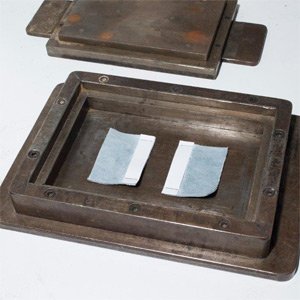Test Method: SATRA TM402C
Preparation of direct-vulcanised bonded test assemblies for adhesion tests
December 2016

SCOPE
This method is intended to describe the preparation and bonding, with heat curing rubber adhesives, of direct-vulcanised test specimen assemblies for use in peel tests. The method is applicable to all types of vulcanisable rubber, against suitably heat resistant flexible materials such as leather or textile.
PRINCIPLE
Standard procedures are used to prepare bonded test assemblies using techniques as close as possible to those used in shoe manufacture, particularly for sole attaching. The method is applicable to moulded-on test assemblies for the peel test, SATRA TM401. The procedure described in this test method simulates the method most commonly used in the shoe factory for the production of footwear with solid rubber vulcanised moulded-on soles (‘direct vulcanised’) by compression moulding. The rubber, initially in the form of a flat ‘blank’, is vulcanised onto an upper material, usually coated with adhesive, in a flat mould inserted between the heated platens of a laboratory press. The method can be used to determine the suitability for direct vulcanising of adherend materials (e.g. rubbers, uppers) with standard curing adhesives, or the suitability of trial adhesives towards standard rubber and upper adherend materials in the direct vulcanising process.
REFERENCES
SATRA TM134 – Density of materials by volume displacement.
SATRA TM401 – Peel strength of adhesive bonds.
HISTORY
First issued as SATRA AM2 July 1981. Revised May 1988, April 1997 (incorporating SATRA AM21). First issued as SATRA TM402C: December 2016.
AVAILABILITY
This test method is available to members and non-members.
PRICE (ex. VAT)
This price is for a printed copy of the Test Method.
- Members: £80
- Non-members: £230


 EN
EN ZH
ZH